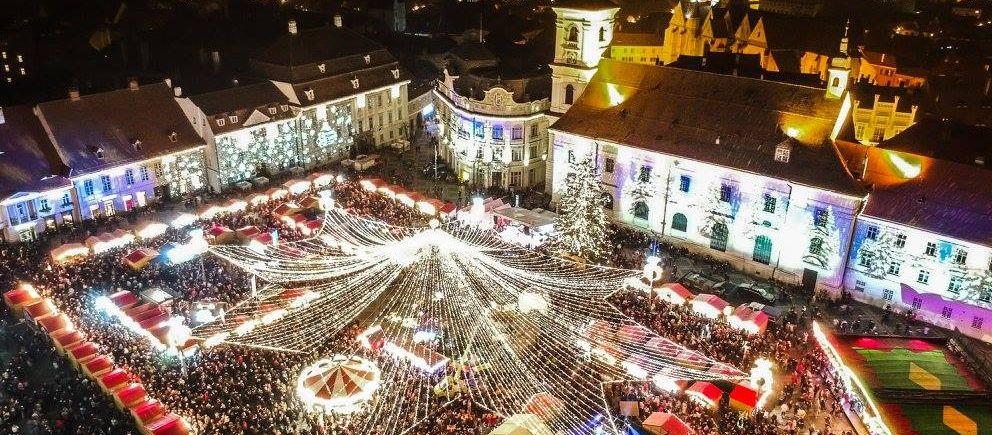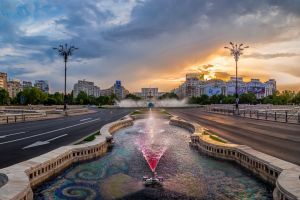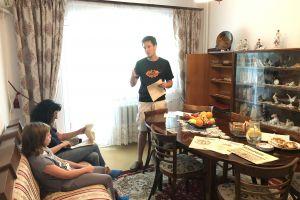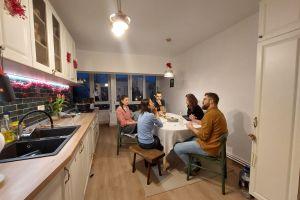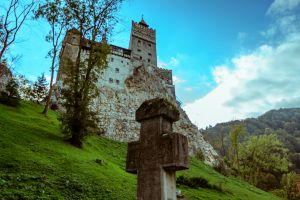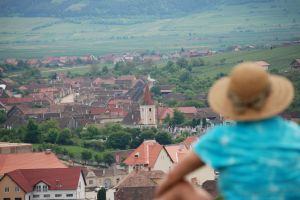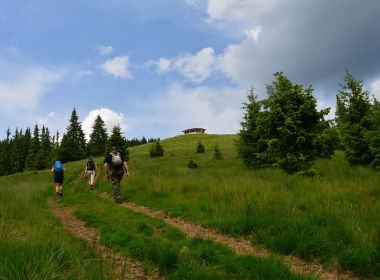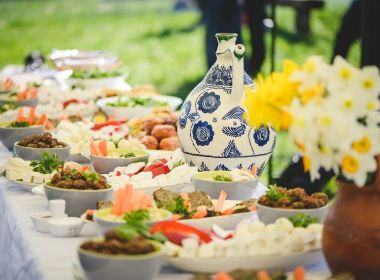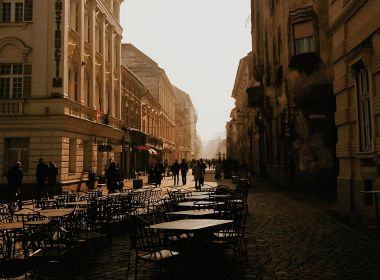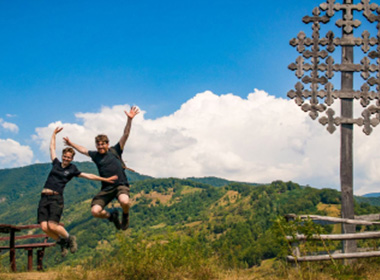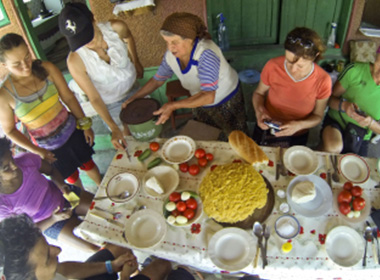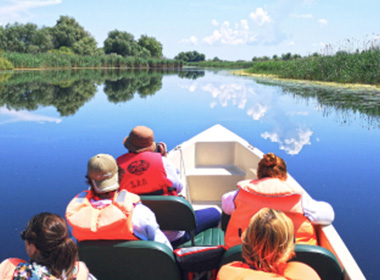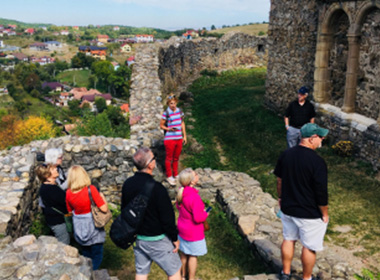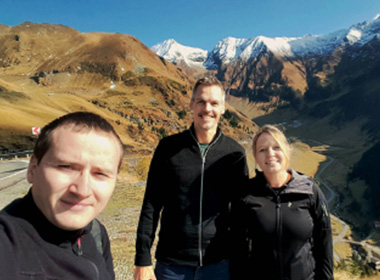Are you planning to visit Romania around December 25 - 26? Then practice saying Craciun fericit! (meaning “Merry Christmas!”) and get ready for a magical celebration! Romania is a unique and charming destination for those looking to spend Christmas in an authentic way.
In today’s article, I want to tell you how Romanians honor Christmas and how you can blend in: where to go, what experiences to have, and some do’s and don’ts.
Beware: before entering any Romanian’s house starting from Christmas Eve (December 24th) until after New Year’s Eve you’ll have to:
- (at least) hum Romanian Christmas carols or watch a group of local carol singers live (and give them a small tip)
- get ready for a food triathlon in the form of a multi-course meal with traditional dishes and drinks in each home you visit
- come with gifts for children (at least sweats) and/or a bottle of wine, and place them underneath the Christmas tree
- receive A LOT of hospitality and prepare a range of variations for “no, thank you, I’m full!”
- blend in with a typical Christmas dinner's laughter, joy, and festive atmosphere.
Christmas is not just any holiday for Romanian families. In Orthodox Christianity (85% of Romanians), the birth of Jesus is an important religious holiday.
Yet, there's something else that explains the over-the-top festive mood during this time of the year…
You see, more than 30 years ago, religious celebrations were banned in communist Romania. Winters were bleak and cold, with little food and no joy.
Now, fast-forward to today’s large family gatherings with an abundance of food, gifts, Christmas lights, and joy! Sure, the Western, Coke-drinking Santa Claus is now present in big cities and shopping malls with its typical consumerist culture, discounts, Christmas decorations and events. But the original Christmas spirit is still present, especially in rural and traditional regions. Participating in holiday traditions is one of the best reasons to visit Maramures or Bukovina.
But in this one, we’re going to explore what this celebration is like and how to best experience it.
Table of contents
- 1. When is Christmas in Romania celebrated
- 2. Other major holidays in December
- 3. How Romanians Celebrate Christmas
- 4. Christmas Eve and winter traditions in Romania
- 5. History and Significance of Romanian Christmas Traditions
- 6. Traditional dishes and drinks for the Christmas Meal
- 7. Experiencing Romanian Christmas Culture
- 8. Where are the best Romanian Christmas Markets
- Conclusion
1. When is Christmas in Romania celebrated
We celebrate Christmas on December 25th. You may hear of the old-fashioned Julian calendar Christmas, which has a 13-day delay, thus placing the celebration on January 7th. This is the case in Russia, and many of our neighbors including Ukraine, Republic of Moldova or Serbia.
The unification of Transylvania, Bessarabia, and Bukovina with the Romanian Kingdom in 1918 is a significant historical event that has influenced many Romanian traditions, including Christmas. Romania switched to the Gregorian calendar in 1924, so locals eagerly await the good news of the birth of baby Jesus on the same date as the Western world.
All of the winter in Romania is magical, but December is special. Leading up to Christmas, a series of important holidays make December an all-around celebration month.
2. Other major holidays in December
It all starts in late November, with Saint Andrew's Day. Saint Andrew is the patron saint of Romania, therefore November 30th is declared a national holiday.
The very next day, on December 1st, we have another public holiday, as we celebrate Romania's National Day, also known as Great Union Day. Keep in mind that many people have time off around these days, and tourist attractions are closed, although you can still enjoy numerous celebrations and parades all over the country!
Despite having partied just days earlier, as many Romanians have family, friends, and acquaintances celebrating on Saint Andrew's Day, the magic of the season starts to seep in around December 6th, when Romanians celebrate Saint Nicholas Day. Saint Nicholas is commonly known as Old Man Nicholas (or _Moș Nicolae_ in Romanian) and he is known to make house calls and put small gifts in the boots of Romanian children—but only if they behave! If they did not, they might find wooden sticks instead.
Then, on *December 20th,* there is a special holiday called Saint Ignatius Day, where people gather to sacrifice the pig they will eat on Christmas Day. This ritual is important and well-kept, especially in rural areas.
Typically, the Romanian custom dictates that the head of the household makes the ritual gesture. Then, the extended family prepares the meat they will enjoy during the festive meals (sausages, cured ham, lard, and more; nothing gets wasted!).
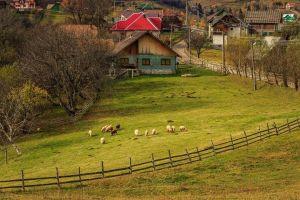
3-Day BEST of Transylvania Tour: Brasov, Sighisoara, Bran & Viscri
Start from: Bucharest
Finally, in the days leading up to Christmas Eve (December 24th), locals go into a frenzy with last-minute shopping for food, gifts, and decorations. In every Romanian city, everyone is in a hurry, shopping malls are overcrowded, and traffic is heavy!
The Christmas tree is decorated a couple of days before, just in time for Santa Clause to pass by during the night to place gifts for everyone underneath. Carol singers roam through the streets and some people go to church for the evening mass.
Christmas Day (December 25th) is reserved for family visits, gift exchanges, heavy meals, and long walks towards the local Christmas Market in the city.
December 25th and 26th are public holidays in Romania and again, all major tourist attractions are closed.
Listen to some traditional Romanian Christmas carols
Although many Orthodox holidays coincide with Catholic holidays around this time, there might be slight differences.
For example, in some Western countries, the Feast of Epiphany is celebrated on January 6th. It is closely linked to the birth of Jesus (the arrival of the Three Wise Men with gifts on the scene of the Nativity).
This holiday is known as Little Christmas. January 6th is also an important holiday in our country, but it represents Saint John the Baptist's baptism of Christ.
3. How Romanians Celebrate Christmas
While our grandparents and older generations still remember the times when Christmas celebrations could not be expressed, younger generations dive headfirst into the festivities this time of the year brings.
In Romania, all the major cities are brightly decorated with twinkling lights. There's a giant Christmas tree and a market around the main public square. You'll find the most beautiful Christmas markets in Bucharest, Sibiu, Brasov, Cluj-Napoca, Craiova and Timisoara.
Some people will still have at home some rare, hand-made glass Christmas decorations that has been passed down from generation to generation. Wood, ceramic, and handcrafted items are also beautiful to see. You can even find some in a Christmas market.
If you travel in the countryside, you will notice big differences in how people celebrate in big cities compared to Romanian villages.
Local tip:with the Carpathian Mountains occupying 55% of our country's territory, if you're a fan of winter sports you might want to read more about the ski resorts in Romania.
The Christmas holiday in rural areas tends to be more toned-down and closely follows the traditions of this important religious celebration. For some, celebrating Christmas does not start until morning, after church mass, when they can end their nativity fast.
Urban or rural, this day is dedicated to family members for most Romanians. In guesthouses, special programs present Romanian local customs for the holiday season, especially in the Northern areas of Maramures and Bucovina, where you can even have dinner dressed in traditional clothes.
Does Santa Claus visit Romania? He does now!
Gift-giving is still a thing, but mostly among family members and close friends. Secret Santa is slowly gaining ground in urban areas, where it is practiced in companies and schools, along with other Western-world Christmas traditions, like kissing under the mistletoe and listening to well-known carols. Santa Claus comes to Romanian children, too. However, waiting till morning is not necessarily part of the traditions.
During the communist regime in Romania, Moș Crăciun (Old Man Christmas), seen as an American tradition, was replaced by a Soviet version of Father Christmas, called Mos Gerila (Old Man Frost), who was stern and brought few presents. It was just a political adaptation to the reality of the times...
4. Christmas Eve and winter traditions in Romania
Depending on which parts of Romania you visit for Christmas, you will witness various Romanian Christmas traditions. As with most peoples converted to Christianity, the new religious rituals and celebrations were placed on top of pagan holidays so locals would have an easier time integrating them.
Decorating Christmas trees is one of the most beloved traditions. It used to be done mainly on Christmas Eve (just like carol singing door-to-door was reserved for this night alone), but with so many stores and other venues propping up trees everywhere, it's harder for most to hold on until the 24th to decorate the one at home.
[tour slug='travel-back-in-time-eight-days-in-maramures-and-bukovina']
Since its date is in the middle of winter in Romania, it was placed over celebrations meant to scare away evil spirits who were said to take advantage of the longer winter nights and lurk in the shadows. Therefore, if you come across a Christmas parade or spend time in rural areas, you will see people wearing hideous masks and making a lot of noise.
Some of the most impressive traditions to ward off evil spirits can be experienced in the region of Maramures, where young people wear traditional clothes under sheep skins and bell necklaces adorned with grotesque masks.
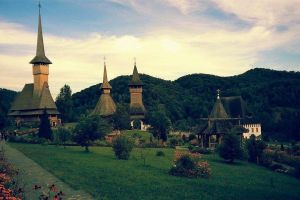
2 or 3 Days in Maramures: Wooden Churches, Traditions & Village Life
Start from: Cluj-Napoca
The same type of celebrations can be observed around New Year's, when various animals, like the Bear and the Goat, join the procession against bad luck and evil to chase them away from the hopeful new year and wish for a year with good crops.
Suppose the accommodation you chose is in a prosperous rural area in Romania. It will be a great opportunity to experience an authentic holiday season in a place of breathtaking natural beauty. Your hosts can also plan sleigh rides and prepare a warm place for guests by the fire outside to take part in the preparation of some of the festivities.
The same type of celebrations can be observed around New Year's, when various animals, like the Bear and the Goat, join the procession against evil to chase it away from the hopeful new year.
In Cluj County, for example, one of the most popular Christmas traditions revolves around caroling and spreading the good news. Unmarried young men in the village of Marisel will dance and sing carols in front of the Church and are allowed to ask unmarried young women to dance.
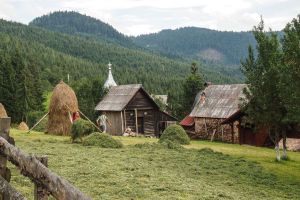
2 Day Hiking in Apuseni Natural Park: Culture & Local Life
Start from: Cluj-Napoca or Sibiu
5. History and Significance of Romanian Christmas Traditions
Romania has a rich history and interesting traditions dating back to the country’s Christianization in the 4th century. The Romanian Orthodox Church has deeply influenced these traditions, incorporating elements from pagan ancient customs and folklore.
The significance of the holiday lies in celebrating the birth of Jesus Christ and bringing families and communities together in a spirit of joy and unity.
Caroling, in particular, holds a special place in Romanian culture among Christmas traditions. Groups, often children or young adults, go from door to door singing traditional Christmas carols, spreading holiday cheer and the story of the Nativity. Today, the tradition is best preserved in small communities, so you’ll need to visit a village to experience it.
And to contribute to the season's magic, the most popular Christmas traditions revolve around carol singers. Traditionally, carolers, made up of groups of children, unmarried men, or married people, go from door to door on Christmas Eve (Ajunul Craciunului) to spread the news of the birth of Jesus and the arrival of the three wise men.
The "star carol" is the most famous traditional Romanian carol, the first that children in Romania learn. It's very popular in Transylvania where you can hear it in German and Hungarian too, a reflection of the region's cultural richness.
In the true tradition of Orthodox Christians, there is a clear distinction between Romanian Christmas carols, telling the story as inspired by religious texts, and Christmas songs, which have gained more popularity thanks to the ‘Western way’ of celebrating the winter holidays.
6. Traditional dishes and drinks for the Christmas Meal
Christmas in Romania revolves a lot around food. The Romanian holiday dinner is constructed around the pork meat from the pig sacrificed on St. Ignat Day. People prepare:
- pork chops, steak and sarmale (seasoned meat and rice stuffed in cabbage leaves that go great with sour cream)
- toba (looks like a giant sausage made from pork meat suspended in aspic, served as an appetizer)
- caltabos (a special type of boiled sausage mixed with garlic and herbs)
- piftie (aspic made from chicken, pork, or turkey)
- boeuf salad (beef or chicken meat, potatoes, carrots, pickles, mixed with mayo)
- a variety of pickled vegetables
- the star of the meal : cozonaci (a type of sweet bread with poppy seed, cocoa, nuts, or Turkish delight filling)
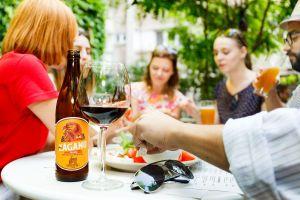
Bucharest Street Food Tour: Farmers' Markets & Hidden Streets
Start from: University Square
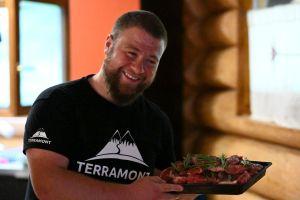
Cluj-Napoca Food Tour: Food Markets, Regional Dishes and Coffee Culture
Start from: Cluj-Napoca
Traditionally, the main focus is on pork-based foods. I recommend trying the local dishes instead of the Western roast gammon and smoked ham if you are having a traditional Christmas dinner.
Apart from cozonaci, every family completes the menu with whatever they view as traditional sweets, like sponge cake. It all goes down great with mulled wine and tuica, the traditional Romanian spirit. Also, when visiting people's homes, you might notice that most Romanians have a version of homemade wine.
And in case you're wondering, how can Romanians handle such high-calorie, heavy meals for two to three days?
Once again, it is a memory of the hard years of poverty endured under the communist regime, but one that created a dynamic of its own even if younger generations did not experience those times.
7. Experiencing Romanian Christmas Culture
Experiencing Romanian culture on Christmas is a unique and unforgettable adventure. From the charming Christmas markets to the traditional dinner, there are countless ways to immerse yourself in the festive atmosphere of this beautiful country.
One of the best ways to dive into Christmas celebrations it is by visiting one of the many charming markets scattered across the country. These markets, found in cities and towns alike, are a feast for the senses. Stalls brimming with handmade crafts, local delicacies, and festive decorations create a magical ambiance.
8. Where are the best Romanian Christmas Markets
After so much sitting and eating, city dwellers love walking. All the big cities in Romania boast of having the most beautiful Christmas markets.
Indeed, each city will have one filled with small houses selling handmade crafts like tree ornaments made of dried oranges and cinnamon, knitted toys, leather products, and traditional food producers with cured meat, cheese, and sweets like gingerbread, cozonaci, and homemade chocolate. Delicious Romanian souvenirs to take home - or decorative trinkets to put on your shelf!
The Sibiu Christmas Market, followed by the ones in Bucharest and Oradea, is said to be the best. The ones from Brasov, Craiova, Iasi, and Timisoara are runner-ups.
As all these markets tend to become very crowded, you may want to check our article with safety tips when visiting Romania to ease your concerns.
The market in Sibiu has an ice-skating rink, a giant Ferris wheel (the main attraction for those looking to snap the perfect picture, although there is quite a long queue before you manage to get on), neatly organized producer stalls, and much more.
In the evening, an MC is coordinating the event, and Mos Craciun (Santa Clause) usually appears and talks to the children.
Professional singers perform Romanian carols or international Christmas songs. It's impossible not to get in the Christmas spirit when visiting Romania this time!
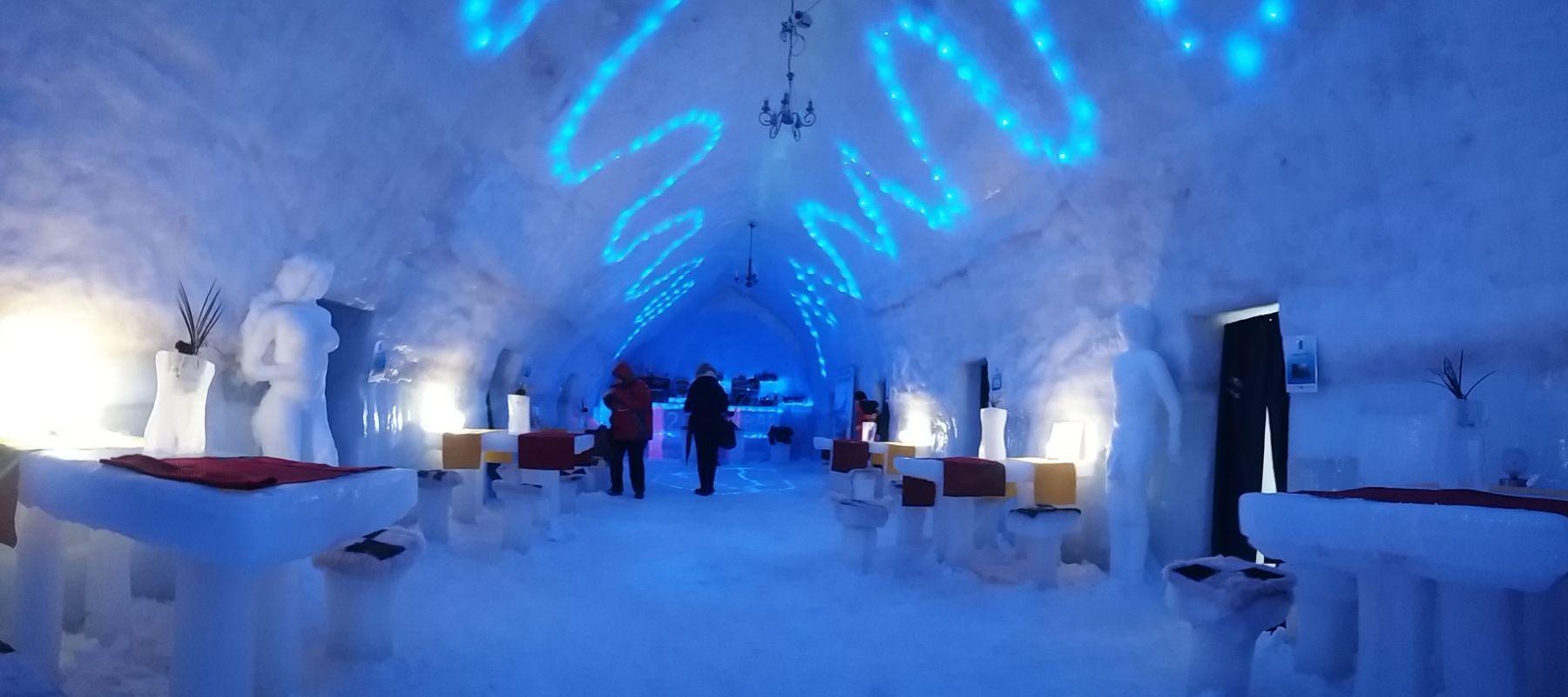
The Balea Ice Hotel at the top of Transfagarasan Road
Conclusion
We encourage you to visit Romania and experience a different Christmas season than you ever did before. With so many holidays to enjoy this time of the year - Saint Andrew Day, Saint Nicholas Day and Christmas - plus all the lights, traditions, delicious food and Christmas markets, the festive mood is guaranteed. December is also a good month to visit Romanian tourist attractions.
Come, enjoy, and tell us which was, in your opinion, the most popular part of Christmas you fell in love with.
Your Romanian Friend,
Elena
